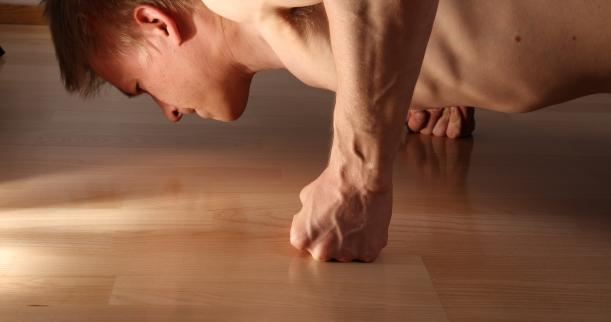The push-up is a great exercise to build numerous muscles in your upper body like your chest, arms, shoulders and back. It requires balance and strength to perform efficiently. However, there are variations of the push-up that can be done by exercisers of all experience levels to increase or decrease difficulty. Arguably the greatest benefit of the push-up is that it can be done anywhere and with or without additional equipment.
Anatomy Involved
The push-up directly targets the pectoralis major which is located in your chest region from your clavicle to your upper abdomen. The pectoralis major has two heads, with the sternal head the primary target of the push-up. The sternal head is located in the lower portion of your chest near your sternum. The second head of the pectoralis major is called the clavicular head and it’s located near your clavicle. Although not directly targeted, the clavicular head of the pectoralis major is actively involved in the push-up. The clavicular head is known as a synergist muscle during the push-up exercise. Synergist muscles assist other muscles in the exercise movement but are not directly targeted.
Other synergists involved in the push-up are the anterior deltoids, which are the front portion of your shoulders, and the triceps brachii which are located on the back portion of the arm between the elbow and the shoulder.
In addition to these muscles, there are numerous others involved in stabilizing joints and keeping proper posture during the push-up. The biceps brachii, located on the front of your arm between the elbow and shoulder, the rectus abdominus, which is your stomach muscles, the obliques, located to the sides of the rectus abdominus, the quadriceps, located in your thighs, and the erectus spinae, located in your mid to low back, all assist in stabilizing the shoulders, elbows, hips, and knees to properly perform the push-up.
Proper Form
To begin, lay face first on the floor with your arms extended outward from your body and your legs extended downward. Your body will look like a ‘T’ before beginning. Next, place your hands palm down on the ground, just outside of your shoulder width. Push yourself up onto your hands and your toes. Your arms will be almost fully extended but do not lock out your elbows. Keep your legs together and your posture straight. Do not round the back or allow your pelvis to sink toward the floor.
Lower yourself toward the floor until your chest or face is about 2 to 3 inches from the ground and then push yourself back up. Repeat this exercise for the desired amount of sets and repetitions.
Beginner Variation
If the standard push-up is too difficult for you to perform then there’s a variation that will make it easier. Instead of extending your legs and pushing up on your toes, beginners may bend their knees and perform the push-up on their hands and knees. This will reduce some of the resistance and strain on the upper body.
Intermediate Variation
For those who are able to perform the standard push-up without any problems, there are variations to make it more difficult. To slightly increase the difficulty of the standard push-up, you can elevate your feet off the ground by using a box, bench, chair or step. This will increase the resistance on the upper body and make the standard push-up more challenging. If you prefer not to elevate your feet, then you can do the push-ups on your knuckles instead of your hands flat on the ground. Using your knuckles will increase instability and force your muscles to work harder to remain balanced throughout the movement.
Advanced Variations
For those who are more advanced exercisers, there are several variations of the standard push-up that can increase the difficulty to provide a more challenging workout. Perhaps, the simplest way to increase difficulty is to add weight. You can place a weighted plate on your back to make the push-up more challenging. If you are at home, you can add phone books, milk jugs, paint cans or other household items that will lay flat on your back while you perform the push-up.
Another advanced variation is the clapping push-up. As you lower yourself to the ground, instead of coming back up in the traditional fashion, you explosively push yourself off the ground so that your hands and feet come completely off the ground. While in mid-air, you try to clap your hands before landing back on your hands and feet. Always keep your body as perfectly aligned as possible. This variation does provide added impact on the wrists and feet, which may be a concern for those with weaker joints or previous joint injuries.
Injury Prevention
In all variations of the push-up, make sure you perform the exercise smoothly and under control. Doing push-ups too quickly can decrease the effectiveness of the exercise and can also lead to losing your balance and sustaining an injury. Never round your back as this could lead to a back injury. Keep your head and neck aligned with the rest of your torso. This will prevent any neck strains. Keep your hips and pelvis aligned with your torso as this will prevent any low back injuries. Make sure your elbows remain slightly bent to prevent any joint injuries.
For more information go to The Muscle Experiment Bodyweight Training Program
 AtoZfitness – Free Fitness Magazine Publishing Only The best Fitness Articles & The Best FItness Products
AtoZfitness – Free Fitness Magazine Publishing Only The best Fitness Articles & The Best FItness Products

